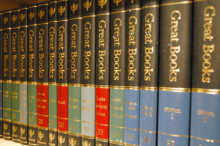Adler, Hutchins, and The Great Books

In the 1930’s, Hutchins had reorganized the undergraduate program at Chicago around a core of “Great Books” taught by the Socratic method. There were no electives. Hutchins backed this with a “Great Books Foundation” and an intensive, and popular, adult education program. (Incidentally, he abolished football at Chicago in 1939.)
In 1942-3, William Benton, a former advertising executive and a friend of Hutchins, persuaded him to undertake a publishing project reflecting the “Great Books” program. Mortimer Adler, who played Long John Silver to Hutchins’ Captain Flint, executed the project.
Thus came about the “Great Books of The Western World (GBWW)”, a uniform set of 54 volumes (later 60) covering 74 authors and 443 works including a two-volume Syntopicon, a novel sort of topical guide and index. Along with the books themselves, Hutchins and Adler promoted “Great Book Discussion Groups.”
When initial sales disappointed, Hutchins and Adler used the Encyclopedia Britannica (Benton was the publisher of the Britannica) sales force. This opened them to scathing criticism, but it worked.
The GBWW was a solid success into the late sixties. Thousands of sets were sold and discussion groups sprang up all over.
Then the world changed, as it does. The GBWW is no longer sold, although some discussion groups continue, and several small colleges have built their operations on the “core curriculum” idea.
All this has been brought back to mind by Alex Beam, a Boston journalist, in A Great Idea at the Time: the rise, fall and curious afterlife of the Great Books (PublicAffairs, 2008). Mr. Beam lays out the story and has a lot of low fun with the eccentricities of those involved, and, to be sure, he has a good deal of timber.
Here, however, I don’t mean to review the book, but to reflect a little on the project itself, as a response to the times.
At the end of the Second World War, fifty nine million dead had suggested to many that society needed, well, readjustment. Things were not working.
There were lots of suggestions. This was the summer of General Semantics, among other schemes. Philosophy was as open as anything else to a re-evaluation.
Now, in reforming, one can go deep and narrow, or try for less radical results along a broad front.
Voegelin took the first approach. He argued that philosophy as a whole had jumped the rails right after Plato, hardening into doctrine, losing sight of its basis in concrete individual experience, and making itself vulnerable to ideological rascals. He had seen the rot of Europe’s intellectual elite, and its results (those 59 million), and he addressed his work to an elite and fairly narrow audience in academia.
Leo Strauss, also of the University of Chicago, I think, worked roughly the same way.
Hutchins, Adler, & Co. took the other path.
They hoped, first of all, to provide a unifying canon of authoritative works that would act for America (and Canada, too) as Homer did for the Greeks and the Five Classics for the Chinese.
Secondly, Adler (he was the team philosopher), while he would have agreed with Voegelin that philosophy had gone wrong, put the error point at some time after St. Thomas Aquinas. Alder was a neo-scholastic at heart and he wasn’t the only one at the time. As he saw it, there was a perfectly good philosophic tradition available; we just had to dust it off and promote it.
Thirdly, they put their faith in popularizing philosophy. Their argument was not so much with what sort of philosophy was being done, although they thought that that needed fixing, as with the fact that only a few people did philosophy at all. The Great Books program, was, I think, a part of what we may call the grand democratization of learning after the war, a movement whose chief monument was the great GI education bill. We sometimes forget how few people had had a chance to go to university before the war. Now things were…different. The whisper had begun to go around that you don’t need to go to Harvard to be cultured, and a lot of people were ready to believe it.
The GBWW, as a set of books, had bad flaws. The type was tiny. There were no indices and introductions. The selection of texts was narrow (Dead White Males and lots of ’em) and sometimes eccentric. The sales methods were often aggressive.
Nevertheless, the intent behind the books and behind the book discussion groups was neither ignoble, nor a complete failure. Learning was encouraged and facilitated, and, not just by solitary study but by discussion, in the best democratic vein. If the tree did not bear fruit on all branches — well, we can’t really tell where it paid off, can we?
There is a lot to ponder here, and we may return to this subject at a later date.




